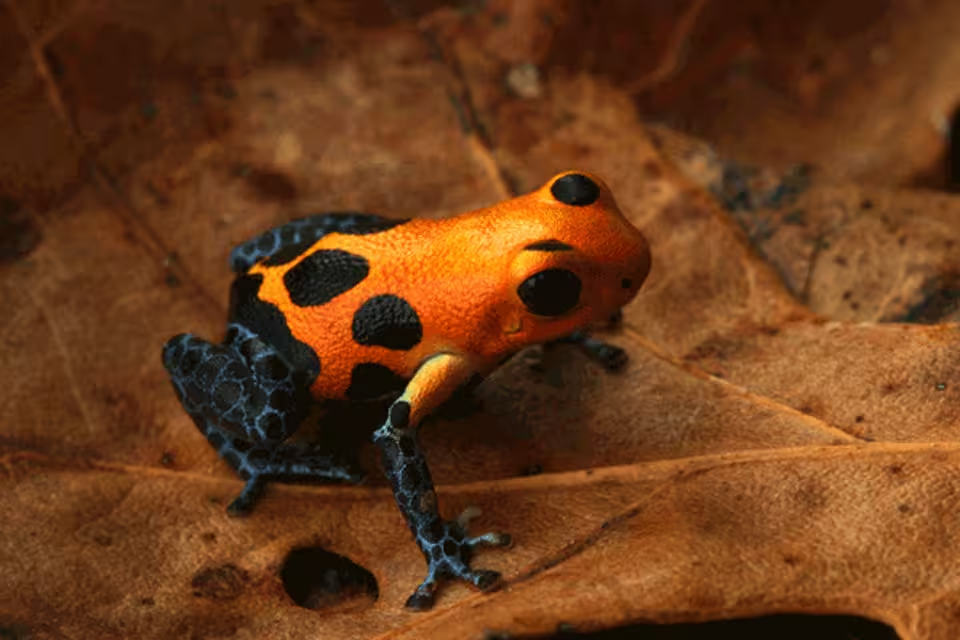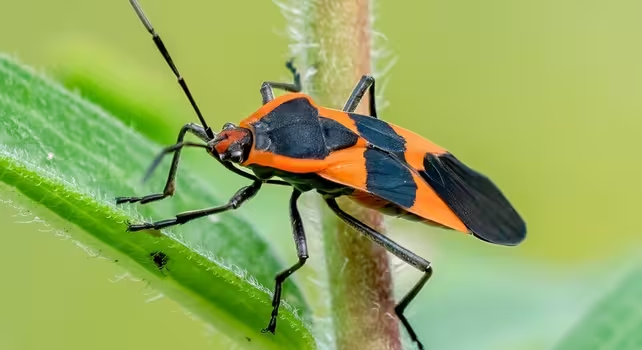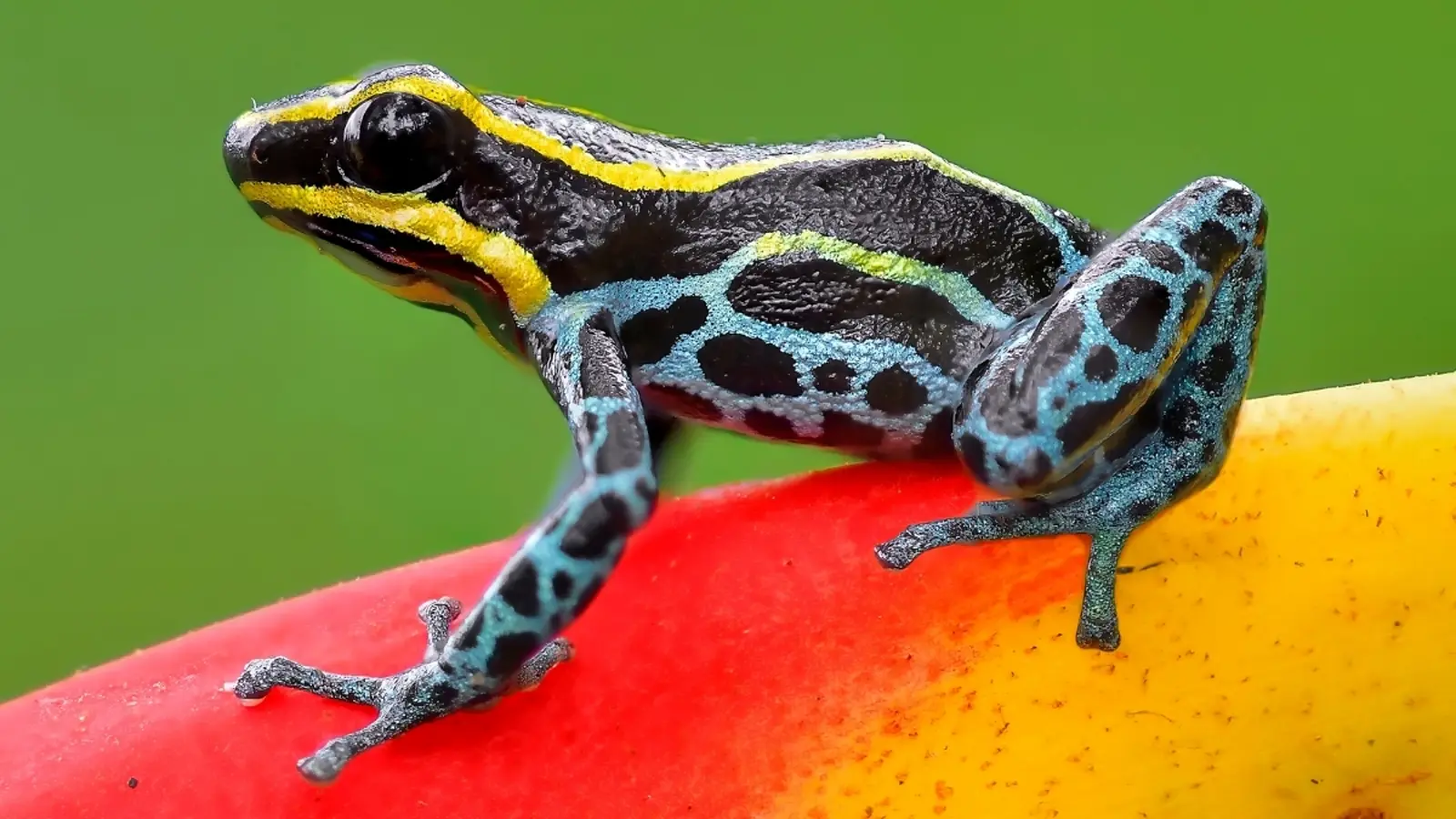9 Minutes
In the tangled ecosystems of the Amazon and beyond, animals are locked in a biochemical arms race. Predators, prey and parasites manufacture, sequester, and sidestep deadly molecules — and sometimes clever behaviors, not just molecular tricks, decide who survives. Recent experiments with royal ground snakes and poison dart frogs offer a vivid window into how animals manage, neutralize, or even repurpose toxic compounds in the wild.
When snakes “wipe” toxins off their prey
Researchers working with snakes collected from the Colombian Amazon observed an unexpected behavior: some royal ground snakes (Erythrolamprus reginae) dragged highly toxic three-striped poison dart frogs (Ameerega trivittata) across the ground before consuming them. In a controlled study, 10 snakes that had been without food were offered these frogs. Six declined the meal and starved rather than risk poisoning. Four attacked; three survived after dragging the frog across the substrate first.

That dragging action resembles behaviors seen in other animals — notably some birds that rub toxic prey against branches or rocks to remove surface-borne poisons. The snakes’ survival suggests that mechanical removal of toxin-coated skin, combined with internal detox strategies, might reduce toxin exposure enough for their physiology to cope.
How animals become poisonous — and how others resist
Toxicity arises through several ecological pathways. Some species synthesize toxic compounds themselves. For example, toads in the bufonid family produce cardiac glycosides that target the sodium-potassium ATPase — a vital protein that maintains ion gradients across cell membranes needed for nerve impulses and muscle contraction. Other organisms gain toxins indirectly: puffer fish host tetrodotoxin-producing microbes, making their flesh dangerous to predators and humans alike. A third route is dietary acquisition: many poison frogs concentrate toxins from arthropods they eat; those alkaloids then advertise danger through bright coloration.
Natural selection favors individuals that can avoid death by these compounds. One common solution is target-site resistance: the molecular target of a toxin evolves amino acid changes that prevent binding. Milkweed-feeding insects, for instance, have altered versions of the sodium-potassium pump so cardiac glycosides bind less effectively. But these adaptations often come with trade-offs. Altering a protein central to cell physiology can reduce its efficiency, particularly in highly sensitive tissues like the brain.
Transporters, tissues and trade-offs
Molecular work by researchers studying milkweed bugs and hawk moths suggests alternate strategies that avoid compromising vital proteins. Proteins in the ATP-binding cassette (ABC) family — especially ABCB transporters — can act as molecular bouncers, pumping toxins out of cells. In some insects, ABCB proteins appear concentrated around neural tissue, effectively protecting the brain while other tissues tolerate different pump variants. Other insects may keep toxins confined to the gut and rapidly excrete them, making their feces or cuticle unpalatable to predators without disrupting their own physiology.
The takeaway: resistance is often a multi-layered defense combining altered targets, selective expression of vulnerable genes, and active transport systems that marshal toxins away from sensitive tissues.
Snake livers, toxin sponges and blood-based defenses
For the royal ground snake, recent cell-culture experiments point to the liver as a key battlefield. Extracts of snake liver appear to neutralize amphibian alkaloids in vitro, implying enzymatic transformations that convert toxic molecules into benign metabolites — much as humans metabolize alcohol and nicotine. Another possible mechanism is sequestration: liver proteins that bind and sequester toxins, effectively acting as molecular sponges that prevent toxins from reaching their targets.
Similar “sponge” strategies have been described elsewhere in nature. Some poison frogs possess blood proteins that bind to dietary alkaloids like saxitoxin, rendering them harmless within the frog but still effective when deployed as a defense. California ground squirrels show a related pattern: blood proteins in some populations neutralize key components of rattlesnake venom, offering partial immunity and buying time during predator encounters.
Those blood-borne defenses often have a local signature. Venom composition varies among snake populations, and evidence shows prey populations can evolve matching antitoxins that are geographically tuned to the venoms they encounter most frequently. That localized coevolution fuels perpetual innovation on both sides — new venom components select for new defenses, and vice versa.
Co-opting toxins: turning poison into armor
Beyond resistance, many species have learned to repurpose toxins as tools. Some insects sequester plant-derived cardiac glycosides and store them on their exoskeletons or in defensive glands. The iridescent dogbane beetle, for instance, draws cardiac glycosides from its host plants and then exudes droplets on its dorsal surface when threatened, making the beetle distasteful to predators.
Iconic examples include monarch butterflies, which incorporate milkweed glycosides into their tissues. That sequestration confers protection and creates ecological ripple effects. Predators that can tolerate or detoxify those compounds — such as several specialized birds and insects — exploit monarchs or milkweed feeders as food. Studies have traced surprising evolutionary connections: a molecule produced by a plant in one region can shape predator-prey interactions thousands of miles away by traveling, through food webs, between species.

The large milkweed bug feeds and lives on plants that contain deadly cardiac glycosides. (Rhododendrites/Wikimedia Commons/CC-BY-SA 4.0)
Why the arms race matters for ecosystems and medicine
These biochemical skirmishes influence species distributions, community structure and food-web dynamics. A few milligrams of an alkaloid can alter predator decisions, reproductive success, and even migration. From a human perspective, studying natural detoxification strategies has practical value: enzymes or binding proteins that neutralize toxins could inspire better antivenoms, small-molecule antidotes, or emergency treatments for poisoning.
Researchers are already translating insights from nature into biomedical leads. The identification of proteins that bind saxitoxin-like molecules hints at biologically derived antidotes. Likewise, understanding how ABC transporters shuttle hazardous compounds across membranes could guide drug-delivery technologies or new ways to block harmful molecules from entering sensitive tissues.
Behavioral first lines of defense
Biochemistry is only half the story. Many animals employ simple behavioral tactics to reduce toxin intake: turtles selectively eat the innards of toxic newts while avoiding their more toxic dorsal skin; monarch predators may target less-toxic life stages; caterpillars damage plant vasculature to drain sap before feeding. The royal ground snakes’ dragging behavior likely fits this suite of first-line defenses: mechanical removal reduces immediate exposure while internal detox mechanisms finish the job.
These layered strategies — avoidance, behavioral mitigation, molecular transporters, enzymatic detoxification, and sequestration — together form the complex tapestry of adaptations that let life persist amid chemical danger.
Expert Insight
"What fascinates me is the economy of solutions in evolution," says Dr. Elena Márquez, a fictional evolutionary toxicologist based at the Institute for Integrative Biology. "Species rarely rely on a single trick. They combine behavior, tissue-specific biochemistry and molecular transporters to manage compounds that would kill most organisms. Those combinations also create predictable signals we can study and, potentially, harness for medicine."
Dr. Márquez continues: "From an applied perspective, identifying liver enzymes or blood proteins that neutralize toxins could reshape how we treat envenomation and poisoning. Nature has already run millions of experiments; our job is to read the results."
Future directions: mapping the molecular chessboard
Going forward, researchers plan to map where resistance genes are expressed, characterize the proteins that bind or metabolize toxins, and test how behaviors contribute to survival under natural conditions. Comparative genomics can illuminate convergent solutions — cases where unrelated lineages evolved similar transporters or binding proteins — while metabolomics will reveal how toxins are chemically transformed inside bodies.
Fieldwork remains vital. Laboratory assays hint at possible mechanisms, but ecological validation — observing how animals behave around toxic prey, how predators select meals, and how toxin levels in the wild fluctuate seasonally — provides the context needed to interpret molecular findings. Combining field natural history with genomics, biochemistry and behavioral experiments will be the fastest path to understanding how organisms manage chemical risk.
Implications for conservation and human health
Toxin-driven interactions also have conservation consequences. Specialist species that depend on toxic resources — like milkweed specialists — are vulnerable to habitat loss and pesticide use. Disrupting those relationships can cascade, altering predator-prey dynamics and removing evolved defenses that might prove medically useful. Protecting habitats where these biochemical relationships evolved preserves both biodiversity and a living laboratory of solutions to toxic challenges.
At a broader level, the chemical arms race underscores a key principle of ecology: interactions matter. A small molecule produced by a plant or microbe can ripple through a food web and shape evolutionary trajectories across continents. Deciphering how animals neutralize, store, and weaponize toxins not only explains survival strategies in the wild but also may provide templates for novel therapies and safer technologies.
Source: sciencealert


Leave a Comment